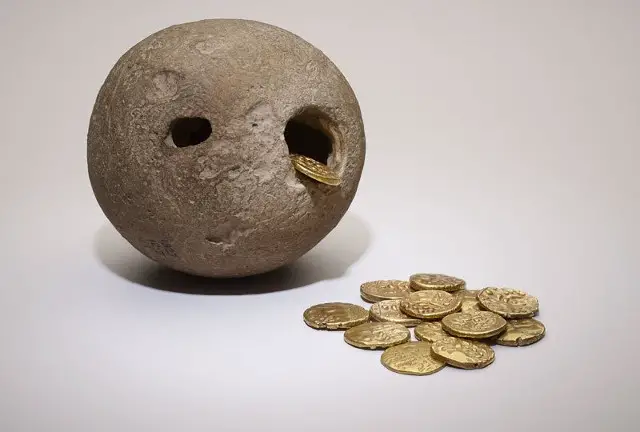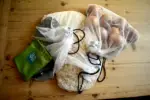Jacque shares details of this latest exhibition at Brading Roman Villa. Ed
Visitors are invited to discover buried treasure in Hoards: a hidden history of ancient Britain, a British Museum and Salisbury Museum Partnership Exhibition, generously supported by the Dorset Foundation.
Hoards focuses on hoarding in ancient Britain, and will be on loan to Brading Roman Villa until 28th September 2019.
Spectacular objects
From Bronze weapons discovered in the river Thames and the first Iron Age coin hoards, through to hoards buried after the collapse of Roman rule in Britain, the exhibition showcases recent discoveries from the general public and reported through the Treasure Act.
Hoards brings together objects, including the spectacular Ipswich Iron Age gold torcs along with new prehistoric and Roman finds from Wessex. The loan is complemented at Brading by the display of coins found locally in Isle of Wight hoards.
Understanding why objects were hidden
The display explores the reasons why ancient people hid precious objects underwater and in the ground over thousands of years. Objects may have been accidentally lost or stolen, discarded as worthless, saved for recycling, hidden for safekeeping or offered up to the gods.
Prehistoric communities deposited hoards as part of rituals to honour gods or ancestors, and to demonstrate power and wealth. Roman coin hoards have traditionally been viewed as being hidden for safekeeping from external threats but new research is changing our understanding of these finds. Careful study of these discoveries has revealed a wealth of information about the past.
Edwards: Collection provides excellent context
Joe Edwards, Dorset Foundation Head of National Programmes at the British Museum, said:
“Touring Hoards: a hidden history of ancient Britain to the Isle of Wight allows a whole new pool of visitors the opportunity to see these fascinating objects, a number of which have been found by members of the public.
“The British Museum is delighted to be working once again with Brading Roman Villa, with its fantastic mosaics and archaeology collection, which will provide an excellent context to how some of the Roman Britons who buried these hoards might have lived.”
Importance of local finds within context of national discoveries
Jasmine Wroath, Curator of Brading Roman Villa, said,
”The Hoards exhibition is a great opportunity to show the importance of our local finds within the context of national discoveries. People have discovered artefacts from all over the Island and recorded these finds through the Portable Antiquities Scheme, which enables us to keep track of these valuable discoveries.
“It’s exciting to keep adding to what we know about ancient people living on the Isle of Wight and try to understand why they buried what they believed to be valuable and worth hiding.”
Where and when
Hoards: a hidden history of ancient Britain opens at Brading Roman Villa from 29th June – 28 September 2019 and is included in the entry ticket to the villa itself.
For more information please call (01983) 406223 or email info@bradingromanvilla.org.uk or see our Website.
Listings information
Opening times: Brading Roman villa is open daily from 10am to 5pm (last entry 4pm).
Ticket prices (includes entry to Hoards: a hidden history of ancient Britain):
£9.50 – Adults
£4.75 – Children (5-16)
£8.75 – Students and Senior Citizens
£25 – Family ticket (up to 2 adults and 3 children)
Brading Roman Villa, Morton Old Road, Brading, Isle of Wight, PO36 0PH





